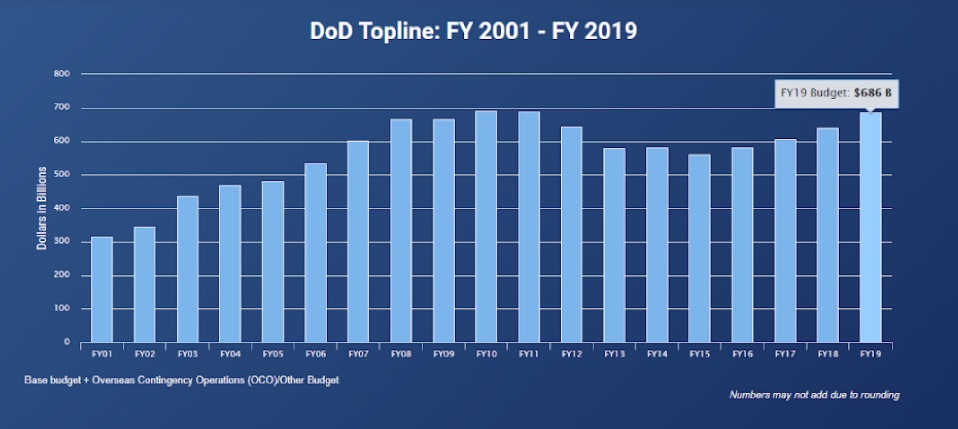It is well to remember that the real bill includes not just DOD spending but VA, intelligence, and more. But those who would cut spending must also propose a new strategy.
It is common in nearly every election cycle for at least one candidate to claim that the United States spends too much on defense. Elizabeth Warren said it last year in a Foreign Affairs article, Bernie Sanders in a Vox interview, and we are likely to hear it again as the general election approaches. Unfortunately, these claims almost always fail to explain just how much America spends on national security, why it traditionally spends so much, or what a major budget cut really entails.
Yes, the United States spends a lot on defense. Probably even more than you think. In fiscal 2019, the Defense Department’s budget, plus money appropriated for nominally unanticipated operational expenses, was $686 billion. A DOD chart shows that amount as part of a trend of generally rising budgets since the September 11, 2001, terrorist attacks, with some reductions after drawdowns in Iraq and Afghanistan began.

To put U.S. military spending in context, it is useful to compare what it spends to that of others. In fiscal 2018, the Defense Department’s budget of $649 billion — not even counting the contingency fund — was larger than the combined spending of the next seven largest militaries: $609 billion (China, Saudi Arabia, India, France, Russia, UK, Germany).
As large as the DOD budget is, the total amount spent by the United States on national security is actually much higher. The largest chunk outside DOD is spent by the Department of Veterans Affairs, which cares for former troops injured in past conflicts and funds the pensions of military retirees. The VA spent $201 billion in 2019, topping $200 million for the first time but not the last; the 2020 request was $220.2 billion. Adding the VA’s budget brings total national-security spending to $887 billion.
America’s nuclear weapons and naval reactors are maintained not by the Pentagon by the Department of Energy’s National Nuclear Security Administration, which also works to counter proliferation and nuclear terrorism. Adding NNSA’s $15.2 billion makes the total $902.2 billion.
It would be remiss not to include the intelligence community, or IC, though this can be a little complicated. The Director of National Intelligence makes public the combined unclassified budgets of the 17 agencies that make up the community. In 2019, that was $81.7 billion. This figure includes $21.5 billion for the Military Intelligence Program (funded by DOD and therefore not added to our burgeoning tally) and $60.2 billion for the National Intelligence Program, which covers non-military organizations such as the CIA. We don’t know how much the Pentagon kicks in for the National Intelligence Program; it could be up to $60.2 billion.
Therefore, America’s true total spending on national security in 2019, when including the DoD, VA, NNSA, and some portion of the IC’s non-military intelligence program, is probably between $902.2 and $962.4 billion. And yet this total does not include domestic security elements such as the Department of Homeland Security (2019: $72.3 billion) or the Federal Bureau of Investigation.









